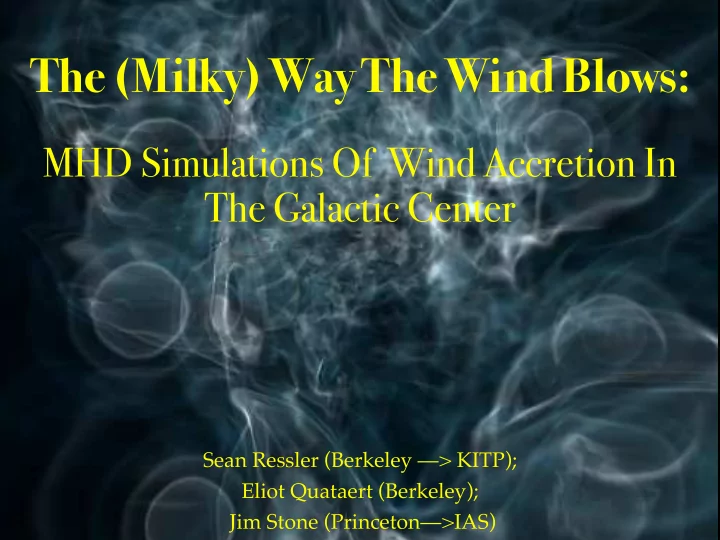

The (Milky) Way The Wind Blows: MHD Simulations Of Wind Accretion In The Galactic Center Sean Ressler (Berkeley —> KITP); � Eliot Quataert (Berkeley); � Jim Stone (Princeton—>IAS)
The (Milky) Way The Wind Blows MHD Simulations Of Wind Accretion In The Galactic Center Sean Ressler (Berkeley —> KITP); � Eliot Quataert (Berkeley); � “Resting mountain climbers” Jim Stone (Princeton—>IAS)
Sean Ressler: Athena++ User Meeting 2019 Sgr A*: Best “Lab” For SMBH Accretion Credit: ESO/Gravity Consortium/L. Calçada ❖ Surrounding stellar population/gas resolved � ❖ Huge amount of data + time variability ❖ Angular size ~ micro arc secs (GRAVITY, EHT) � ❖ Extremely low luminosity (10 -9 Edd) —-> optically thin, geometrically thick, collisionless at small scales Credit: Keck/UCLA Galactic Center Group
Sagittarius A*: A Simple Sketch Sean Ressler: Athena++ User Meeting 2019 Jet? Mini- Spiral Magnetar Sgr A* WR Star Thick Disk S-Star ~1 pc ~ 0.1 pc ~ 0.4 µpc
Sagittarius A*: A Simple Sketch Sean Ressler: Athena++ User Meeting 2019
Sean Ressler: Athena++ User Meeting 2019 Questions I Seek To Address ❖ What limits accretion? Outflow, convection, angular momentum? � ❖ How important are magnetic fields in terms of angular momentum transport? Are they necessary for accretion? � ❖ What conditions lead to a strong jet/outflow? � ❖ Can we explain observables such as the X-ray luminosity (yes), the rotation measures of the black hole (yes) and magnetar (yes, but fine-tuned)? � ❖ What do we predict for the flux threading the black hole? The geometry of the field? � ❖ Which initial/boundary conditions for GRMHD simulations are appropriate?
Sean Ressler: Athena++ User Meeting 2019 Magnetized Wind Simulations Observational Input: � Wind Speeds � WR Stars: Source Terms Mdots � Orbits MHD Parameters: � B = B φ � Spin Axes: Random ~ 1 pc � ~2.5 x 10 5 r H Calculated Orbits ~ 0.6 x 10 -5 pc � ~ 150 r H
Sean Ressler: Athena++ User Meeting 2019 Stellar Wind Magnetic Field
Sean Ressler: Athena++ User Meeting 2019 Stellar Wind Magnetic Field: Work With E
Sean Ressler: Athena++ User Meeting 2019 Stellar Wind Magnetic Field: Work With E Hoop stress finite � Continuous at boundary � at poles of wind Prime = Frame aligned with spin of star
Sean Ressler: Athena++ User Meeting 2019 Small β w : Acceleration and Collimation β w <~ 100 � wind collimates Physical, but complicates � analysis β w <~ 5 � wind accelerates Inconsistent Hereafter: � β w = 100 Massive O-stars: 10% as high as 0.1 - 20 kG at surface
Sean Ressler: Athena++ User Meeting 2019 3D Accretion Simulations White - High Density � Green - Low Density ~0.5 pc
Sean Ressler: Athena++ User Meeting 2019 c.f Proga & Begelman 2008 Hydro: Accretion of Low Angular Momentum Gas Low Angular Momentum, � Accreting Gas High Angular Momentum, � Outflowing Gas ~1000 r S ~ 5 mpc
Sean Ressler: Athena++ User Meeting 2019 c.f Proga & Begelman 2008 MHD: L-Transport and Polar Outflow Magnetically Driven � β ~ 1 � Outflow High Angular Momentum, � β ~ 3 � Accreting Gas ~1000 r S ~ 5 mpc
Sean Ressler: Athena++ User Meeting 2019 MRI Results Came Back Negative MRI: Well resolved, but limited by size of disk
Sean Ressler: Athena++ User Meeting 2019 The More Things Change The More They Stay The Same
Sean Ressler: Athena++ User Meeting 2019 The More Things Change The More They Stay The Same β ~ 3, α ~ 0.2, Mdot basically flow structure unchanged � reversed
Sean Ressler: Athena++ User Meeting 2019 Hydro: In One Ear And Out The Other ~0.1 pc
Sean Ressler: Athena++ User Meeting 2019 MHD: Down- ward Spiral ~ 0.1 pc
Sean Ressler: Athena++ User Meeting 2019 So What Exactly Is Going On? Hydro MHD
Sean Ressler: Athena++ User Meeting 2019 Outflow White - High Temp (> 10 8 K) � Black - “Low” Temp (< 5 x 10 6 K) ~ 10 kyr (hydro) ~ 1.5 kyr (MHD)
Sean Ressler: Athena++ User Meeting 2019 Conclusions ❖ Net accretion onto Sgr A* determined from mostly hydrodynamic considerations: few x 10 -8 Msun/yr � ❖ Field grows by flux freezing/compression, not MRI � ❖ Hydro: high-L gas simply spirals in then out without circularizing, low-L gas accretes � ❖ MHD: Strong coherent fields torque high-L gas, allowing it to accrete � ❖ Magnetic fields, however, still can drive strong outflows
Recommend
More recommend